BUSINESS AND THE BUSINESS ENVIRONMENT
VerifiedAdded on 2021/01/01
|16
|5078
|378
AI Summary
This report is on "SWOT analysis of Tesco". This report contains the different types of organizations that are private organizations, public organizations, their purpose. This report explains the size and scope of Tesco and the relationship of different departments of the organization and explains the positive and negative influence on the macro factors of the environment. One of its legal structures is the corporate governance of Tesco and shareholders' deals in this sector.
Contribute Materials
Your contribution can guide someone’s learning journey. Share your
documents today.
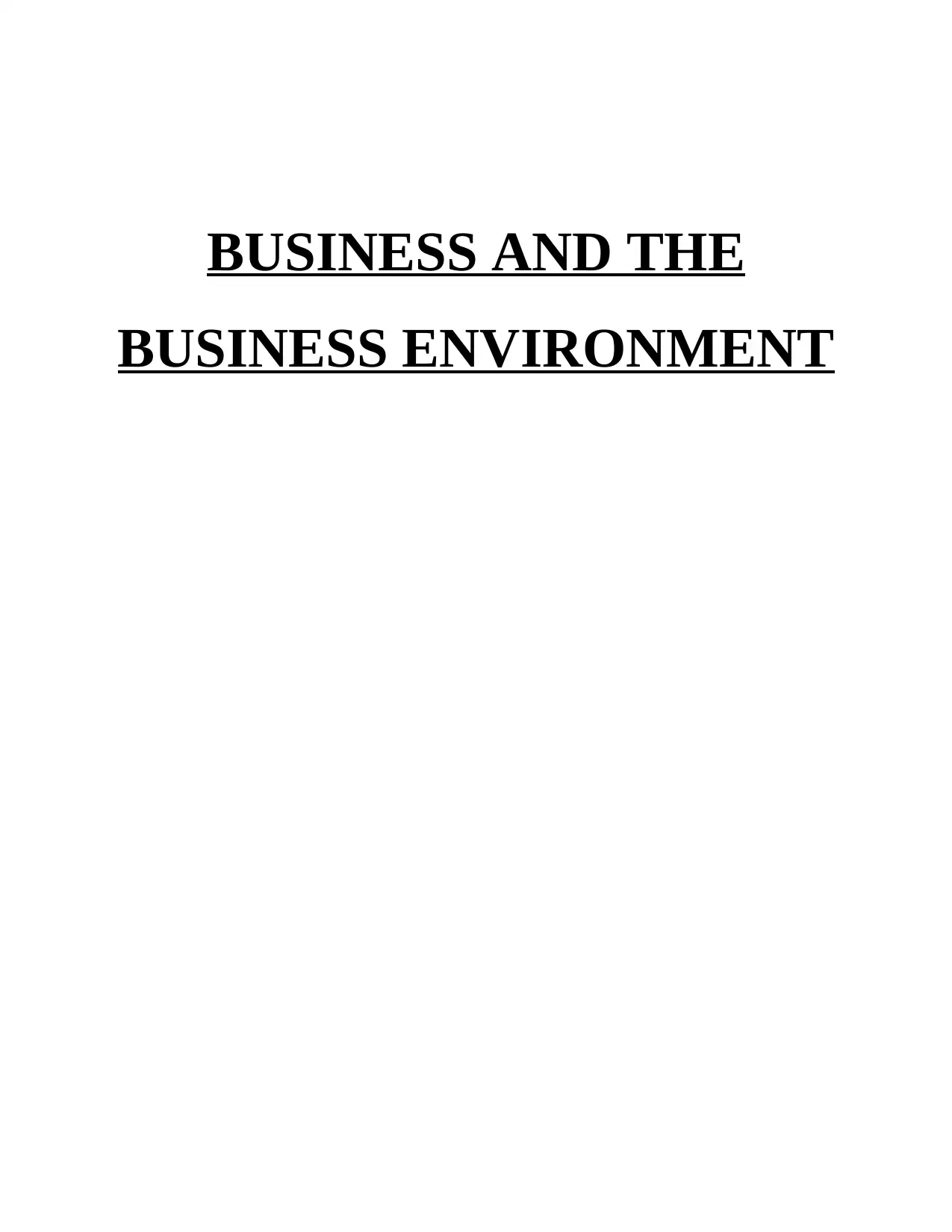
BUSINESS AND THE
BUSINESS ENVIRONMENT
BUSINESS ENVIRONMENT
Secure Best Marks with AI Grader
Need help grading? Try our AI Grader for instant feedback on your assignments.
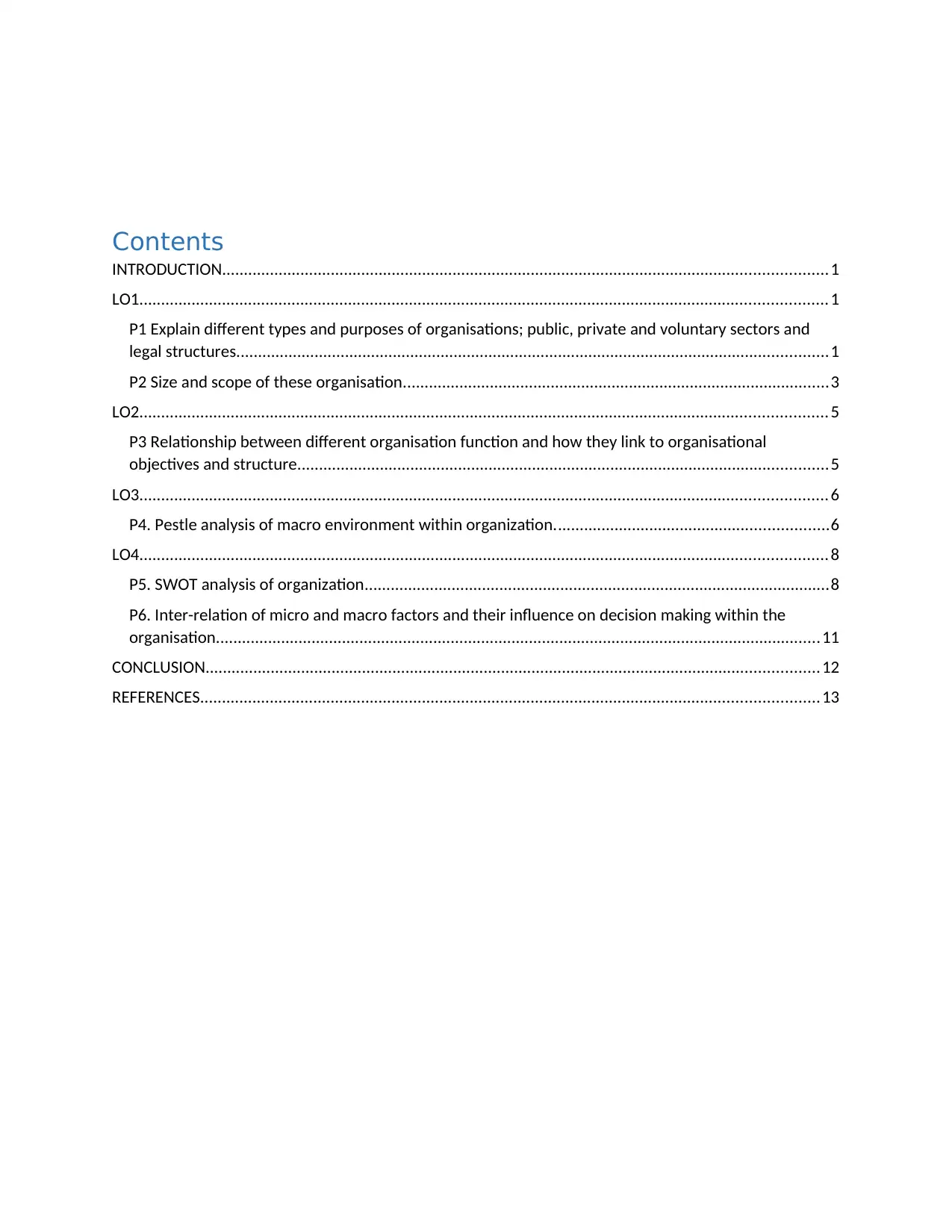
Contents
INTRODUCTION...........................................................................................................................................1
LO1..............................................................................................................................................................1
P1 Explain different types and purposes of organisations; public, private and voluntary sectors and
legal structures........................................................................................................................................1
P2 Size and scope of these organisation..................................................................................................3
LO2..............................................................................................................................................................5
P3 Relationship between different organisation function and how they link to organisational
objectives and structure..........................................................................................................................5
LO3..............................................................................................................................................................6
P4. Pestle analysis of macro environment within organization...............................................................6
LO4..............................................................................................................................................................8
P5. SWOT analysis of organization...........................................................................................................8
P6. Inter-relation of micro and macro factors and their influence on decision making within the
organisation...........................................................................................................................................11
CONCLUSION.............................................................................................................................................12
REFERENCES..............................................................................................................................................13
INTRODUCTION...........................................................................................................................................1
LO1..............................................................................................................................................................1
P1 Explain different types and purposes of organisations; public, private and voluntary sectors and
legal structures........................................................................................................................................1
P2 Size and scope of these organisation..................................................................................................3
LO2..............................................................................................................................................................5
P3 Relationship between different organisation function and how they link to organisational
objectives and structure..........................................................................................................................5
LO3..............................................................................................................................................................6
P4. Pestle analysis of macro environment within organization...............................................................6
LO4..............................................................................................................................................................8
P5. SWOT analysis of organization...........................................................................................................8
P6. Inter-relation of micro and macro factors and their influence on decision making within the
organisation...........................................................................................................................................11
CONCLUSION.............................................................................................................................................12
REFERENCES..............................................................................................................................................13
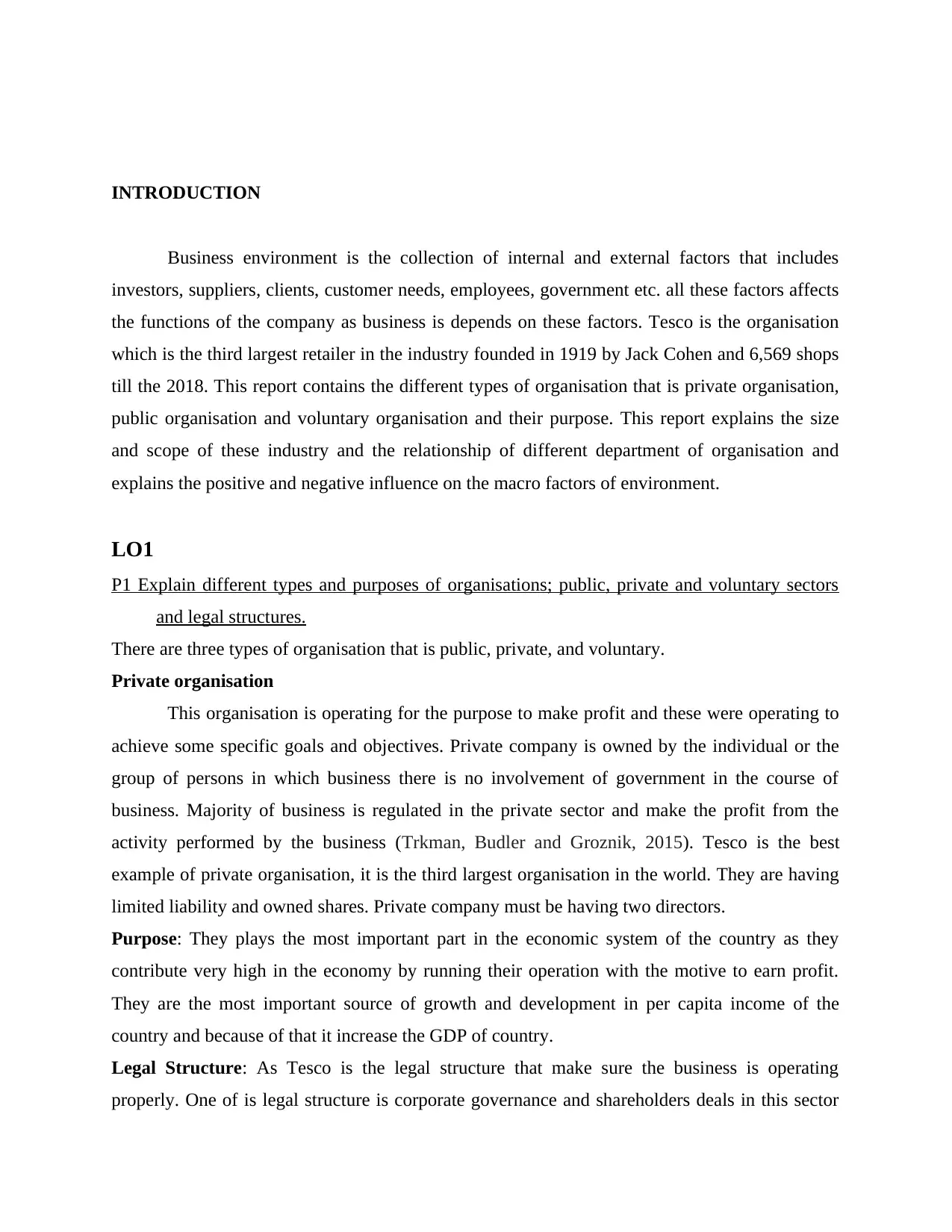
INTRODUCTION
Business environment is the collection of internal and external factors that includes
investors, suppliers, clients, customer needs, employees, government etc. all these factors affects
the functions of the company as business is depends on these factors. Tesco is the organisation
which is the third largest retailer in the industry founded in 1919 by Jack Cohen and 6,569 shops
till the 2018. This report contains the different types of organisation that is private organisation,
public organisation and voluntary organisation and their purpose. This report explains the size
and scope of these industry and the relationship of different department of organisation and
explains the positive and negative influence on the macro factors of environment.
LO1
P1 Explain different types and purposes of organisations; public, private and voluntary sectors
and legal structures.
There are three types of organisation that is public, private, and voluntary.
Private organisation
This organisation is operating for the purpose to make profit and these were operating to
achieve some specific goals and objectives. Private company is owned by the individual or the
group of persons in which business there is no involvement of government in the course of
business. Majority of business is regulated in the private sector and make the profit from the
activity performed by the business (Trkman, Budler and Groznik, 2015). Tesco is the best
example of private organisation, it is the third largest organisation in the world. They are having
limited liability and owned shares. Private company must be having two directors.
Purpose: They plays the most important part in the economic system of the country as they
contribute very high in the economy by running their operation with the motive to earn profit.
They are the most important source of growth and development in per capita income of the
country and because of that it increase the GDP of country.
Legal Structure: As Tesco is the legal structure that make sure the business is operating
properly. One of is legal structure is corporate governance and shareholders deals in this sector
Business environment is the collection of internal and external factors that includes
investors, suppliers, clients, customer needs, employees, government etc. all these factors affects
the functions of the company as business is depends on these factors. Tesco is the organisation
which is the third largest retailer in the industry founded in 1919 by Jack Cohen and 6,569 shops
till the 2018. This report contains the different types of organisation that is private organisation,
public organisation and voluntary organisation and their purpose. This report explains the size
and scope of these industry and the relationship of different department of organisation and
explains the positive and negative influence on the macro factors of environment.
LO1
P1 Explain different types and purposes of organisations; public, private and voluntary sectors
and legal structures.
There are three types of organisation that is public, private, and voluntary.
Private organisation
This organisation is operating for the purpose to make profit and these were operating to
achieve some specific goals and objectives. Private company is owned by the individual or the
group of persons in which business there is no involvement of government in the course of
business. Majority of business is regulated in the private sector and make the profit from the
activity performed by the business (Trkman, Budler and Groznik, 2015). Tesco is the best
example of private organisation, it is the third largest organisation in the world. They are having
limited liability and owned shares. Private company must be having two directors.
Purpose: They plays the most important part in the economic system of the country as they
contribute very high in the economy by running their operation with the motive to earn profit.
They are the most important source of growth and development in per capita income of the
country and because of that it increase the GDP of country.
Legal Structure: As Tesco is the legal structure that make sure the business is operating
properly. One of is legal structure is corporate governance and shareholders deals in this sector
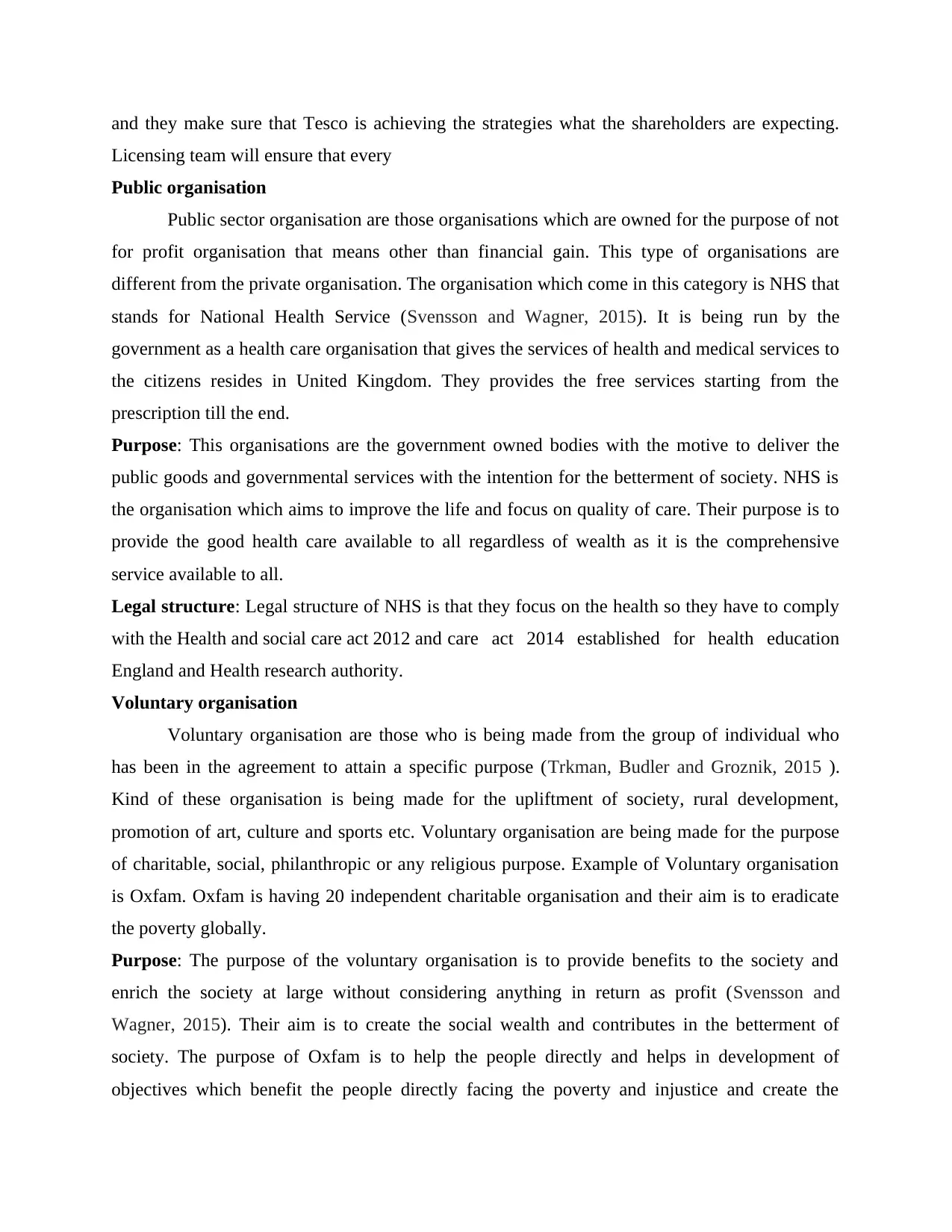
and they make sure that Tesco is achieving the strategies what the shareholders are expecting.
Licensing team will ensure that every
Public organisation
Public sector organisation are those organisations which are owned for the purpose of not
for profit organisation that means other than financial gain. This type of organisations are
different from the private organisation. The organisation which come in this category is NHS that
stands for National Health Service (Svensson and Wagner, 2015). It is being run by the
government as a health care organisation that gives the services of health and medical services to
the citizens resides in United Kingdom. They provides the free services starting from the
prescription till the end.
Purpose: This organisations are the government owned bodies with the motive to deliver the
public goods and governmental services with the intention for the betterment of society. NHS is
the organisation which aims to improve the life and focus on quality of care. Their purpose is to
provide the good health care available to all regardless of wealth as it is the comprehensive
service available to all.
Legal structure: Legal structure of NHS is that they focus on the health so they have to comply
with the Health and social care act 2012 and care act 2014 established for health education
England and Health research authority.
Voluntary organisation
Voluntary organisation are those who is being made from the group of individual who
has been in the agreement to attain a specific purpose (Trkman, Budler and Groznik, 2015 ).
Kind of these organisation is being made for the upliftment of society, rural development,
promotion of art, culture and sports etc. Voluntary organisation are being made for the purpose
of charitable, social, philanthropic or any religious purpose. Example of Voluntary organisation
is Oxfam. Oxfam is having 20 independent charitable organisation and their aim is to eradicate
the poverty globally.
Purpose: The purpose of the voluntary organisation is to provide benefits to the society and
enrich the society at large without considering anything in return as profit (Svensson and
Wagner, 2015). Their aim is to create the social wealth and contributes in the betterment of
society. The purpose of Oxfam is to help the people directly and helps in development of
objectives which benefit the people directly facing the poverty and injustice and create the
Licensing team will ensure that every
Public organisation
Public sector organisation are those organisations which are owned for the purpose of not
for profit organisation that means other than financial gain. This type of organisations are
different from the private organisation. The organisation which come in this category is NHS that
stands for National Health Service (Svensson and Wagner, 2015). It is being run by the
government as a health care organisation that gives the services of health and medical services to
the citizens resides in United Kingdom. They provides the free services starting from the
prescription till the end.
Purpose: This organisations are the government owned bodies with the motive to deliver the
public goods and governmental services with the intention for the betterment of society. NHS is
the organisation which aims to improve the life and focus on quality of care. Their purpose is to
provide the good health care available to all regardless of wealth as it is the comprehensive
service available to all.
Legal structure: Legal structure of NHS is that they focus on the health so they have to comply
with the Health and social care act 2012 and care act 2014 established for health education
England and Health research authority.
Voluntary organisation
Voluntary organisation are those who is being made from the group of individual who
has been in the agreement to attain a specific purpose (Trkman, Budler and Groznik, 2015 ).
Kind of these organisation is being made for the upliftment of society, rural development,
promotion of art, culture and sports etc. Voluntary organisation are being made for the purpose
of charitable, social, philanthropic or any religious purpose. Example of Voluntary organisation
is Oxfam. Oxfam is having 20 independent charitable organisation and their aim is to eradicate
the poverty globally.
Purpose: The purpose of the voluntary organisation is to provide benefits to the society and
enrich the society at large without considering anything in return as profit (Svensson and
Wagner, 2015). Their aim is to create the social wealth and contributes in the betterment of
society. The purpose of Oxfam is to help the people directly and helps in development of
objectives which benefit the people directly facing the poverty and injustice and create the
Secure Best Marks with AI Grader
Need help grading? Try our AI Grader for instant feedback on your assignments.
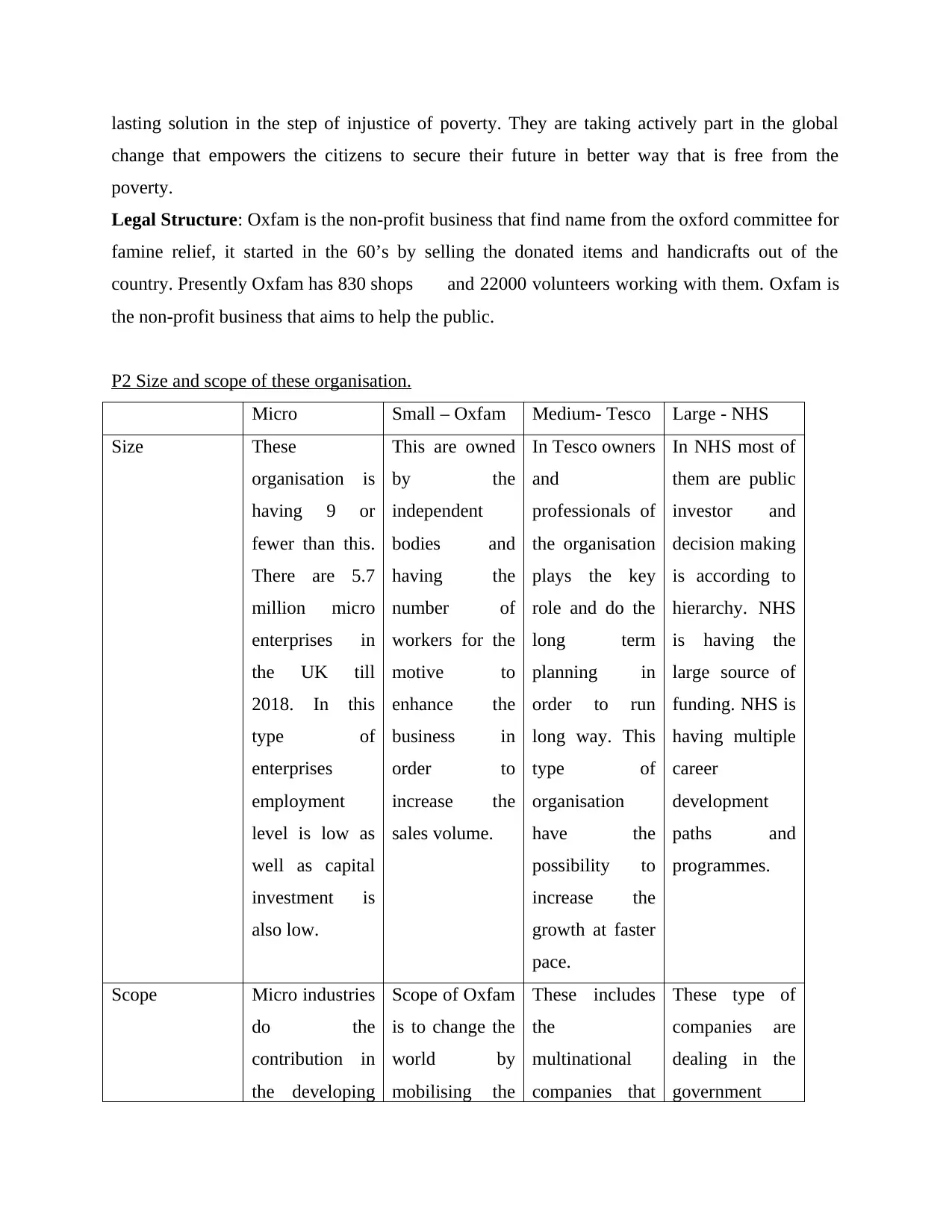
lasting solution in the step of injustice of poverty. They are taking actively part in the global
change that empowers the citizens to secure their future in better way that is free from the
poverty.
Legal Structure: Oxfam is the non-profit business that find name from the oxford committee for
famine relief, it started in the 60’s by selling the donated items and handicrafts out of the
country. Presently Oxfam has 830 shops and 22000 volunteers working with them. Oxfam is
the non-profit business that aims to help the public.
P2 Size and scope of these organisation.
Micro Small – Oxfam Medium- Tesco Large - NHS
Size These
organisation is
having 9 or
fewer than this.
There are 5.7
million micro
enterprises in
the UK till
2018. In this
type of
enterprises
employment
level is low as
well as capital
investment is
also low.
This are owned
by the
independent
bodies and
having the
number of
workers for the
motive to
enhance the
business in
order to
increase the
sales volume.
In Tesco owners
and
professionals of
the organisation
plays the key
role and do the
long term
planning in
order to run
long way. This
type of
organisation
have the
possibility to
increase the
growth at faster
pace.
In NHS most of
them are public
investor and
decision making
is according to
hierarchy. NHS
is having the
large source of
funding. NHS is
having multiple
career
development
paths and
programmes.
Scope Micro industries
do the
contribution in
the developing
Scope of Oxfam
is to change the
world by
mobilising the
These includes
the
multinational
companies that
These type of
companies are
dealing in the
government
change that empowers the citizens to secure their future in better way that is free from the
poverty.
Legal Structure: Oxfam is the non-profit business that find name from the oxford committee for
famine relief, it started in the 60’s by selling the donated items and handicrafts out of the
country. Presently Oxfam has 830 shops and 22000 volunteers working with them. Oxfam is
the non-profit business that aims to help the public.
P2 Size and scope of these organisation.
Micro Small – Oxfam Medium- Tesco Large - NHS
Size These
organisation is
having 9 or
fewer than this.
There are 5.7
million micro
enterprises in
the UK till
2018. In this
type of
enterprises
employment
level is low as
well as capital
investment is
also low.
This are owned
by the
independent
bodies and
having the
number of
workers for the
motive to
enhance the
business in
order to
increase the
sales volume.
In Tesco owners
and
professionals of
the organisation
plays the key
role and do the
long term
planning in
order to run
long way. This
type of
organisation
have the
possibility to
increase the
growth at faster
pace.
In NHS most of
them are public
investor and
decision making
is according to
hierarchy. NHS
is having the
large source of
funding. NHS is
having multiple
career
development
paths and
programmes.
Scope Micro industries
do the
contribution in
the developing
Scope of Oxfam
is to change the
world by
mobilising the
These includes
the
multinational
companies that
These type of
companies are
dealing in the
government
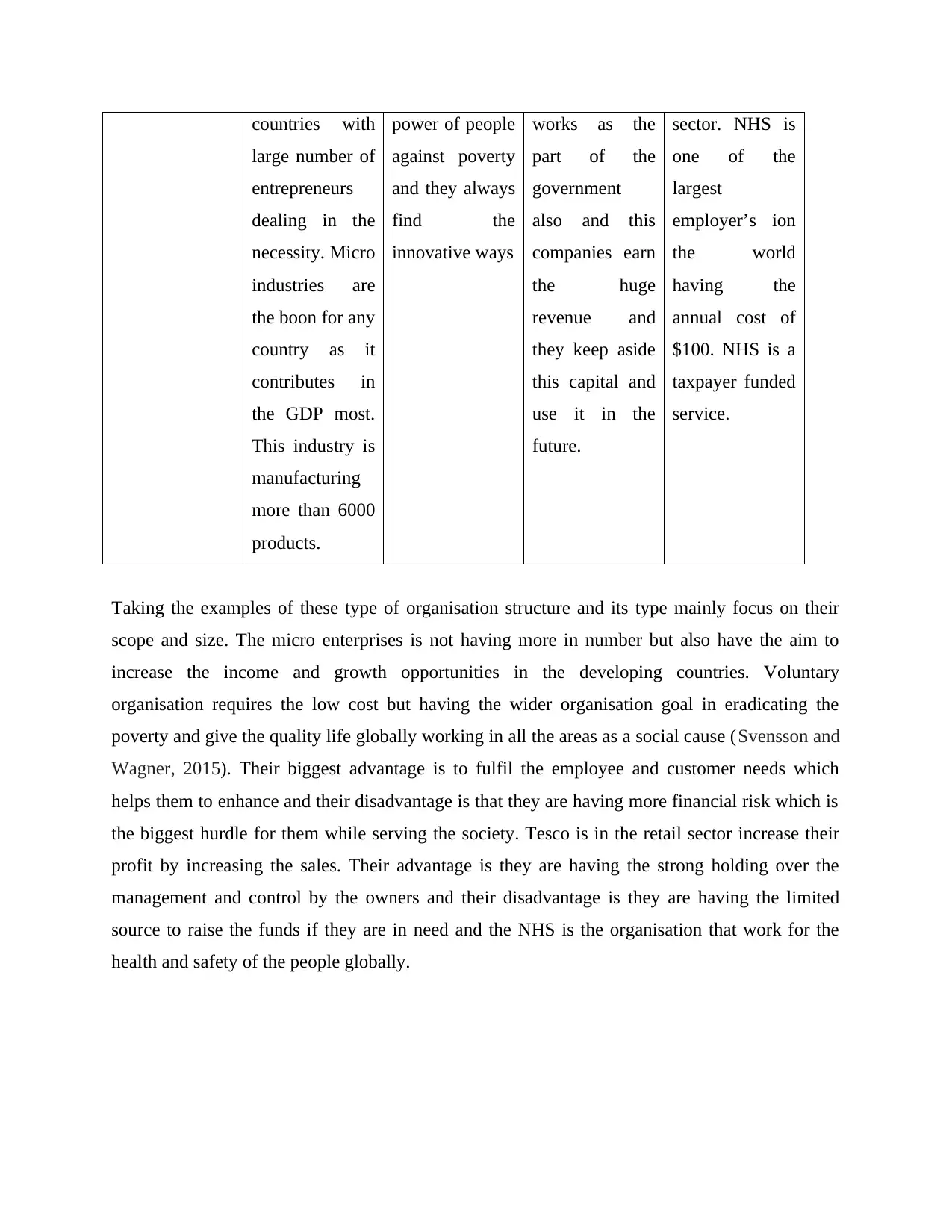
countries with
large number of
entrepreneurs
dealing in the
necessity. Micro
industries are
the boon for any
country as it
contributes in
the GDP most.
This industry is
manufacturing
more than 6000
products.
power of people
against poverty
and they always
find the
innovative ways
works as the
part of the
government
also and this
companies earn
the huge
revenue and
they keep aside
this capital and
use it in the
future.
sector. NHS is
one of the
largest
employer’s ion
the world
having the
annual cost of
$100. NHS is a
taxpayer funded
service.
Taking the examples of these type of organisation structure and its type mainly focus on their
scope and size. The micro enterprises is not having more in number but also have the aim to
increase the income and growth opportunities in the developing countries. Voluntary
organisation requires the low cost but having the wider organisation goal in eradicating the
poverty and give the quality life globally working in all the areas as a social cause (Svensson and
Wagner, 2015). Their biggest advantage is to fulfil the employee and customer needs which
helps them to enhance and their disadvantage is that they are having more financial risk which is
the biggest hurdle for them while serving the society. Tesco is in the retail sector increase their
profit by increasing the sales. Their advantage is they are having the strong holding over the
management and control by the owners and their disadvantage is they are having the limited
source to raise the funds if they are in need and the NHS is the organisation that work for the
health and safety of the people globally.
large number of
entrepreneurs
dealing in the
necessity. Micro
industries are
the boon for any
country as it
contributes in
the GDP most.
This industry is
manufacturing
more than 6000
products.
power of people
against poverty
and they always
find the
innovative ways
works as the
part of the
government
also and this
companies earn
the huge
revenue and
they keep aside
this capital and
use it in the
future.
sector. NHS is
one of the
largest
employer’s ion
the world
having the
annual cost of
$100. NHS is a
taxpayer funded
service.
Taking the examples of these type of organisation structure and its type mainly focus on their
scope and size. The micro enterprises is not having more in number but also have the aim to
increase the income and growth opportunities in the developing countries. Voluntary
organisation requires the low cost but having the wider organisation goal in eradicating the
poverty and give the quality life globally working in all the areas as a social cause (Svensson and
Wagner, 2015). Their biggest advantage is to fulfil the employee and customer needs which
helps them to enhance and their disadvantage is that they are having more financial risk which is
the biggest hurdle for them while serving the society. Tesco is in the retail sector increase their
profit by increasing the sales. Their advantage is they are having the strong holding over the
management and control by the owners and their disadvantage is they are having the limited
source to raise the funds if they are in need and the NHS is the organisation that work for the
health and safety of the people globally.
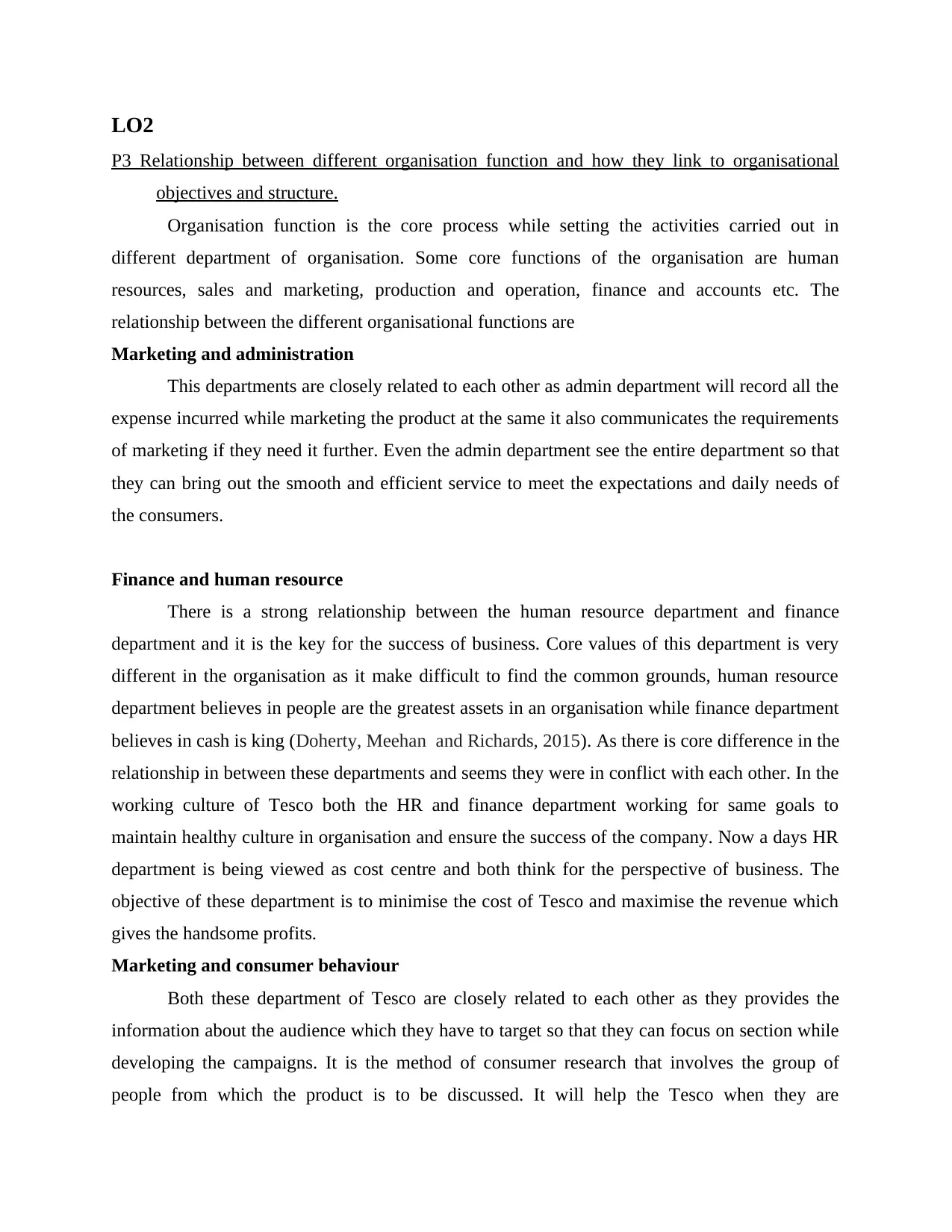
LO2
P3 Relationship between different organisation function and how they link to organisational
objectives and structure.
Organisation function is the core process while setting the activities carried out in
different department of organisation. Some core functions of the organisation are human
resources, sales and marketing, production and operation, finance and accounts etc. The
relationship between the different organisational functions are
Marketing and administration
This departments are closely related to each other as admin department will record all the
expense incurred while marketing the product at the same it also communicates the requirements
of marketing if they need it further. Even the admin department see the entire department so that
they can bring out the smooth and efficient service to meet the expectations and daily needs of
the consumers.
Finance and human resource
There is a strong relationship between the human resource department and finance
department and it is the key for the success of business. Core values of this department is very
different in the organisation as it make difficult to find the common grounds, human resource
department believes in people are the greatest assets in an organisation while finance department
believes in cash is king (Doherty, Meehan and Richards, 2015). As there is core difference in the
relationship in between these departments and seems they were in conflict with each other. In the
working culture of Tesco both the HR and finance department working for same goals to
maintain healthy culture in organisation and ensure the success of the company. Now a days HR
department is being viewed as cost centre and both think for the perspective of business. The
objective of these department is to minimise the cost of Tesco and maximise the revenue which
gives the handsome profits.
Marketing and consumer behaviour
Both these department of Tesco are closely related to each other as they provides the
information about the audience which they have to target so that they can focus on section while
developing the campaigns. It is the method of consumer research that involves the group of
people from which the product is to be discussed. It will help the Tesco when they are
P3 Relationship between different organisation function and how they link to organisational
objectives and structure.
Organisation function is the core process while setting the activities carried out in
different department of organisation. Some core functions of the organisation are human
resources, sales and marketing, production and operation, finance and accounts etc. The
relationship between the different organisational functions are
Marketing and administration
This departments are closely related to each other as admin department will record all the
expense incurred while marketing the product at the same it also communicates the requirements
of marketing if they need it further. Even the admin department see the entire department so that
they can bring out the smooth and efficient service to meet the expectations and daily needs of
the consumers.
Finance and human resource
There is a strong relationship between the human resource department and finance
department and it is the key for the success of business. Core values of this department is very
different in the organisation as it make difficult to find the common grounds, human resource
department believes in people are the greatest assets in an organisation while finance department
believes in cash is king (Doherty, Meehan and Richards, 2015). As there is core difference in the
relationship in between these departments and seems they were in conflict with each other. In the
working culture of Tesco both the HR and finance department working for same goals to
maintain healthy culture in organisation and ensure the success of the company. Now a days HR
department is being viewed as cost centre and both think for the perspective of business. The
objective of these department is to minimise the cost of Tesco and maximise the revenue which
gives the handsome profits.
Marketing and consumer behaviour
Both these department of Tesco are closely related to each other as they provides the
information about the audience which they have to target so that they can focus on section while
developing the campaigns. It is the method of consumer research that involves the group of
people from which the product is to be discussed. It will help the Tesco when they are
Paraphrase This Document
Need a fresh take? Get an instant paraphrase of this document with our AI Paraphraser

introducing new product as it gives the idea how people will react towards the product and what
is the most valuable thing they have. Behaviour of consumer is very important in marketing of
any product and services (Trkman, Budler and Groznik, 2015). Working together of both the
department helps in increasing the sales of product. The objective of both of these department
working together is to understand the consumer needs and do the marketing by keeping the point
to focus on consumer demand.
Marketing and R&D
Department of marketing or research and development are mainly focused in
understanding the needs of customers, if they find the consumer needs it will make their job easy
and their results will going to be very productive, it is very powerful weapon for the Tesco that
increase their marketability of product (Doherty, Meehan and Richards, 2015). Both the
department of Tesco needs to work together as research and development is having the art of
possibility while marketing is the art of possible both the department work together than they can
understand the needs of consumer and then develop the product according to their needs and
make it successful. Working both the department together will achieve the objectives of Tesco
and make the organisation to increase the sales.
LO3
P4. Pestle analysis of macro environment within organization.
The PESTLE tool analyses external environment in which Tesco Plc operates which
includes factors that affect Tesco's productivity and performance. Tesco is a British multinational
trading company, located in Hertfordshire, England. In terms of profit. This is the third largest
nine-story supermarket in the world. The company was founded in 1919 and is currently
represented in 12 countries with more than 6553 stores. Tesco PLC not only offers retail
products, but also markets broadband, cellular and insurance services.
Political factors: These factors include tax rates, current and future laws, political instability,
unemployment and the economic situation of the countries in which the company operates. The
political environment directly and indirectly affects the organization of the company (Kljucnikov
and et.al., 2016). The policy environment consists of various types of government actions in the
country concerned in relation to business organizations, such as quotas, tariffs, government
policies, rules and regulations available to the state. There have been some significant changes in
is the most valuable thing they have. Behaviour of consumer is very important in marketing of
any product and services (Trkman, Budler and Groznik, 2015). Working together of both the
department helps in increasing the sales of product. The objective of both of these department
working together is to understand the consumer needs and do the marketing by keeping the point
to focus on consumer demand.
Marketing and R&D
Department of marketing or research and development are mainly focused in
understanding the needs of customers, if they find the consumer needs it will make their job easy
and their results will going to be very productive, it is very powerful weapon for the Tesco that
increase their marketability of product (Doherty, Meehan and Richards, 2015). Both the
department of Tesco needs to work together as research and development is having the art of
possibility while marketing is the art of possible both the department work together than they can
understand the needs of consumer and then develop the product according to their needs and
make it successful. Working both the department together will achieve the objectives of Tesco
and make the organisation to increase the sales.
LO3
P4. Pestle analysis of macro environment within organization.
The PESTLE tool analyses external environment in which Tesco Plc operates which
includes factors that affect Tesco's productivity and performance. Tesco is a British multinational
trading company, located in Hertfordshire, England. In terms of profit. This is the third largest
nine-story supermarket in the world. The company was founded in 1919 and is currently
represented in 12 countries with more than 6553 stores. Tesco PLC not only offers retail
products, but also markets broadband, cellular and insurance services.
Political factors: These factors include tax rates, current and future laws, political instability,
unemployment and the economic situation of the countries in which the company operates. The
political environment directly and indirectly affects the organization of the company (Kljucnikov
and et.al., 2016). The policy environment consists of various types of government actions in the
country concerned in relation to business organizations, such as quotas, tariffs, government
policies, rules and regulations available to the state. There have been some significant changes in
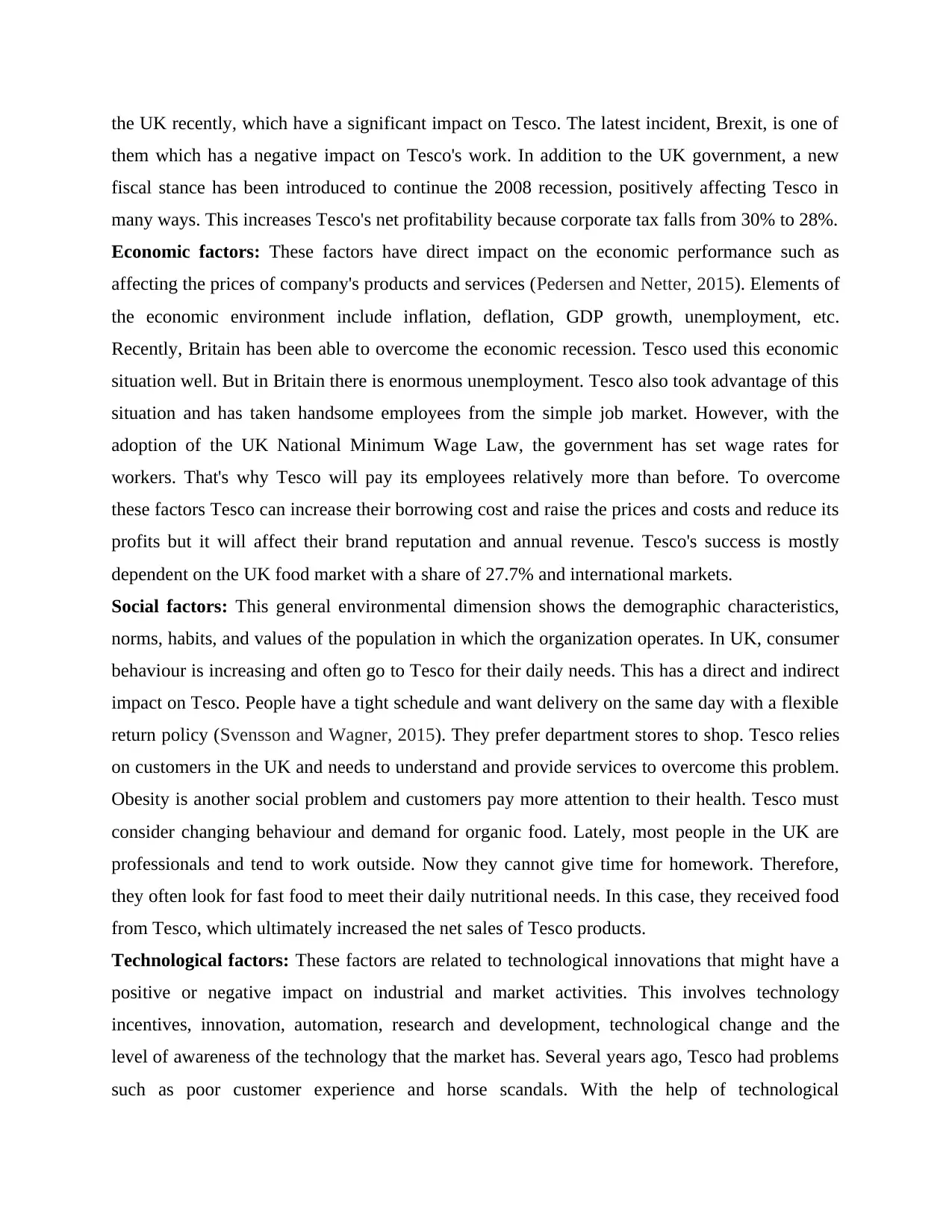
the UK recently, which have a significant impact on Tesco. The latest incident, Brexit, is one of
them which has a negative impact on Tesco's work. In addition to the UK government, a new
fiscal stance has been introduced to continue the 2008 recession, positively affecting Tesco in
many ways. This increases Tesco's net profitability because corporate tax falls from 30% to 28%.
Economic factors: These factors have direct impact on the economic performance such as
affecting the prices of company's products and services (Pedersen and Netter, 2015). Elements of
the economic environment include inflation, deflation, GDP growth, unemployment, etc.
Recently, Britain has been able to overcome the economic recession. Tesco used this economic
situation well. But in Britain there is enormous unemployment. Tesco also took advantage of this
situation and has taken handsome employees from the simple job market. However, with the
adoption of the UK National Minimum Wage Law, the government has set wage rates for
workers. That's why Tesco will pay its employees relatively more than before. To overcome
these factors Tesco can increase their borrowing cost and raise the prices and costs and reduce its
profits but it will affect their brand reputation and annual revenue. Tesco's success is mostly
dependent on the UK food market with a share of 27.7% and international markets.
Social factors: This general environmental dimension shows the demographic characteristics,
norms, habits, and values of the population in which the organization operates. In UK, consumer
behaviour is increasing and often go to Tesco for their daily needs. This has a direct and indirect
impact on Tesco. People have a tight schedule and want delivery on the same day with a flexible
return policy (Svensson and Wagner, 2015). They prefer department stores to shop. Tesco relies
on customers in the UK and needs to understand and provide services to overcome this problem.
Obesity is another social problem and customers pay more attention to their health. Tesco must
consider changing behaviour and demand for organic food. Lately, most people in the UK are
professionals and tend to work outside. Now they cannot give time for homework. Therefore,
they often look for fast food to meet their daily nutritional needs. In this case, they received food
from Tesco, which ultimately increased the net sales of Tesco products.
Technological factors: These factors are related to technological innovations that might have a
positive or negative impact on industrial and market activities. This involves technology
incentives, innovation, automation, research and development, technological change and the
level of awareness of the technology that the market has. Several years ago, Tesco had problems
such as poor customer experience and horse scandals. With the help of technological
them which has a negative impact on Tesco's work. In addition to the UK government, a new
fiscal stance has been introduced to continue the 2008 recession, positively affecting Tesco in
many ways. This increases Tesco's net profitability because corporate tax falls from 30% to 28%.
Economic factors: These factors have direct impact on the economic performance such as
affecting the prices of company's products and services (Pedersen and Netter, 2015). Elements of
the economic environment include inflation, deflation, GDP growth, unemployment, etc.
Recently, Britain has been able to overcome the economic recession. Tesco used this economic
situation well. But in Britain there is enormous unemployment. Tesco also took advantage of this
situation and has taken handsome employees from the simple job market. However, with the
adoption of the UK National Minimum Wage Law, the government has set wage rates for
workers. That's why Tesco will pay its employees relatively more than before. To overcome
these factors Tesco can increase their borrowing cost and raise the prices and costs and reduce its
profits but it will affect their brand reputation and annual revenue. Tesco's success is mostly
dependent on the UK food market with a share of 27.7% and international markets.
Social factors: This general environmental dimension shows the demographic characteristics,
norms, habits, and values of the population in which the organization operates. In UK, consumer
behaviour is increasing and often go to Tesco for their daily needs. This has a direct and indirect
impact on Tesco. People have a tight schedule and want delivery on the same day with a flexible
return policy (Svensson and Wagner, 2015). They prefer department stores to shop. Tesco relies
on customers in the UK and needs to understand and provide services to overcome this problem.
Obesity is another social problem and customers pay more attention to their health. Tesco must
consider changing behaviour and demand for organic food. Lately, most people in the UK are
professionals and tend to work outside. Now they cannot give time for homework. Therefore,
they often look for fast food to meet their daily nutritional needs. In this case, they received food
from Tesco, which ultimately increased the net sales of Tesco products.
Technological factors: These factors are related to technological innovations that might have a
positive or negative impact on industrial and market activities. This involves technology
incentives, innovation, automation, research and development, technological change and the
level of awareness of the technology that the market has. Several years ago, Tesco had problems
such as poor customer experience and horse scandals. With the help of technological
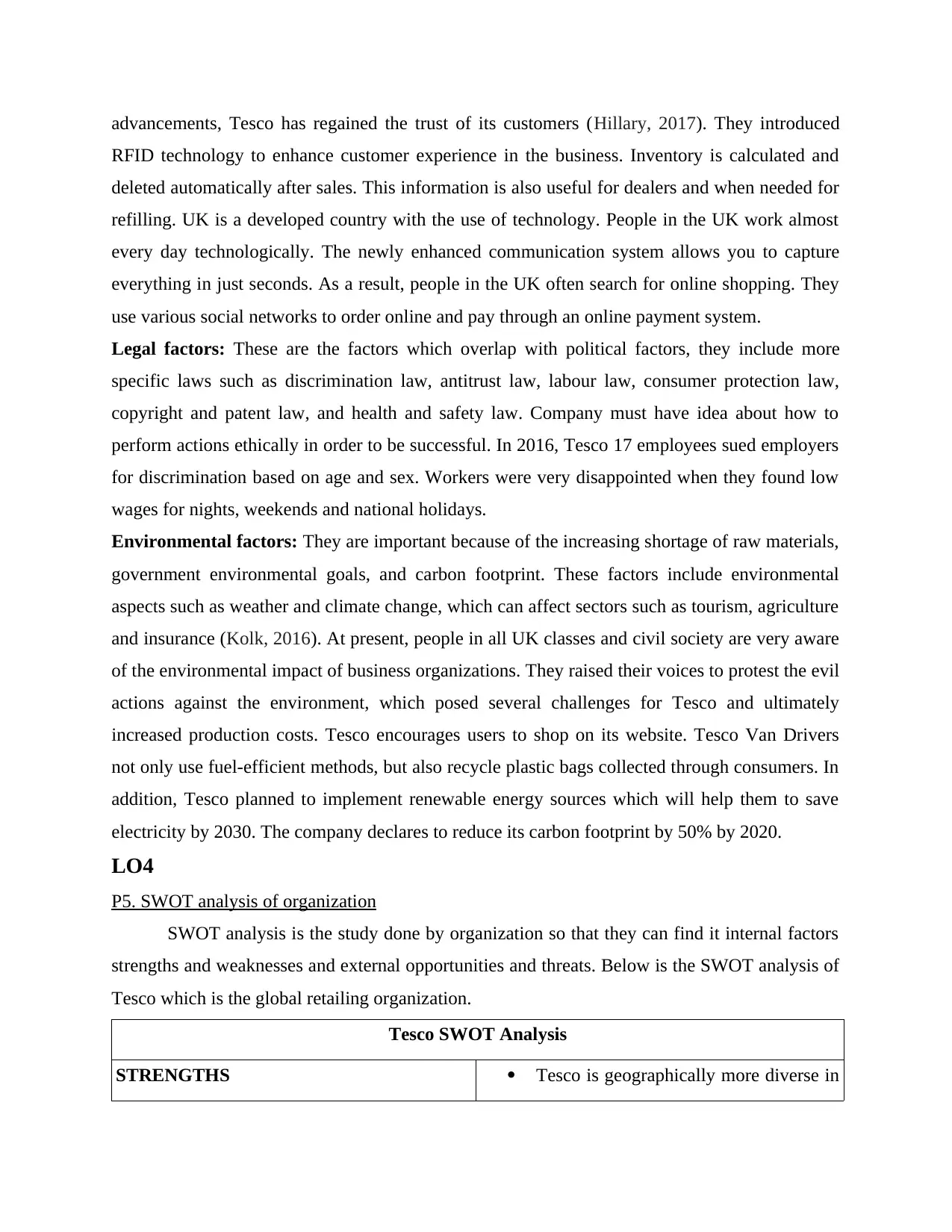
advancements, Tesco has regained the trust of its customers (Hillary, 2017). They introduced
RFID technology to enhance customer experience in the business. Inventory is calculated and
deleted automatically after sales. This information is also useful for dealers and when needed for
refilling. UK is a developed country with the use of technology. People in the UK work almost
every day technologically. The newly enhanced communication system allows you to capture
everything in just seconds. As a result, people in the UK often search for online shopping. They
use various social networks to order online and pay through an online payment system.
Legal factors: These are the factors which overlap with political factors, they include more
specific laws such as discrimination law, antitrust law, labour law, consumer protection law,
copyright and patent law, and health and safety law. Company must have idea about how to
perform actions ethically in order to be successful. In 2016, Tesco 17 employees sued employers
for discrimination based on age and sex. Workers were very disappointed when they found low
wages for nights, weekends and national holidays.
Environmental factors: They are important because of the increasing shortage of raw materials,
government environmental goals, and carbon footprint. These factors include environmental
aspects such as weather and climate change, which can affect sectors such as tourism, agriculture
and insurance (Kolk, 2016). At present, people in all UK classes and civil society are very aware
of the environmental impact of business organizations. They raised their voices to protest the evil
actions against the environment, which posed several challenges for Tesco and ultimately
increased production costs. Tesco encourages users to shop on its website. Tesco Van Drivers
not only use fuel-efficient methods, but also recycle plastic bags collected through consumers. In
addition, Tesco planned to implement renewable energy sources which will help them to save
electricity by 2030. The company declares to reduce its carbon footprint by 50% by 2020.
LO4
P5. SWOT analysis of organization
SWOT analysis is the study done by organization so that they can find it internal factors
strengths and weaknesses and external opportunities and threats. Below is the SWOT analysis of
Tesco which is the global retailing organization.
Tesco SWOT Analysis
STRENGTHS Tesco is geographically more diverse in
RFID technology to enhance customer experience in the business. Inventory is calculated and
deleted automatically after sales. This information is also useful for dealers and when needed for
refilling. UK is a developed country with the use of technology. People in the UK work almost
every day technologically. The newly enhanced communication system allows you to capture
everything in just seconds. As a result, people in the UK often search for online shopping. They
use various social networks to order online and pay through an online payment system.
Legal factors: These are the factors which overlap with political factors, they include more
specific laws such as discrimination law, antitrust law, labour law, consumer protection law,
copyright and patent law, and health and safety law. Company must have idea about how to
perform actions ethically in order to be successful. In 2016, Tesco 17 employees sued employers
for discrimination based on age and sex. Workers were very disappointed when they found low
wages for nights, weekends and national holidays.
Environmental factors: They are important because of the increasing shortage of raw materials,
government environmental goals, and carbon footprint. These factors include environmental
aspects such as weather and climate change, which can affect sectors such as tourism, agriculture
and insurance (Kolk, 2016). At present, people in all UK classes and civil society are very aware
of the environmental impact of business organizations. They raised their voices to protest the evil
actions against the environment, which posed several challenges for Tesco and ultimately
increased production costs. Tesco encourages users to shop on its website. Tesco Van Drivers
not only use fuel-efficient methods, but also recycle plastic bags collected through consumers. In
addition, Tesco planned to implement renewable energy sources which will help them to save
electricity by 2030. The company declares to reduce its carbon footprint by 50% by 2020.
LO4
P5. SWOT analysis of organization
SWOT analysis is the study done by organization so that they can find it internal factors
strengths and weaknesses and external opportunities and threats. Below is the SWOT analysis of
Tesco which is the global retailing organization.
Tesco SWOT Analysis
STRENGTHS Tesco is geographically more diverse in
Secure Best Marks with AI Grader
Need help grading? Try our AI Grader for instant feedback on your assignments.
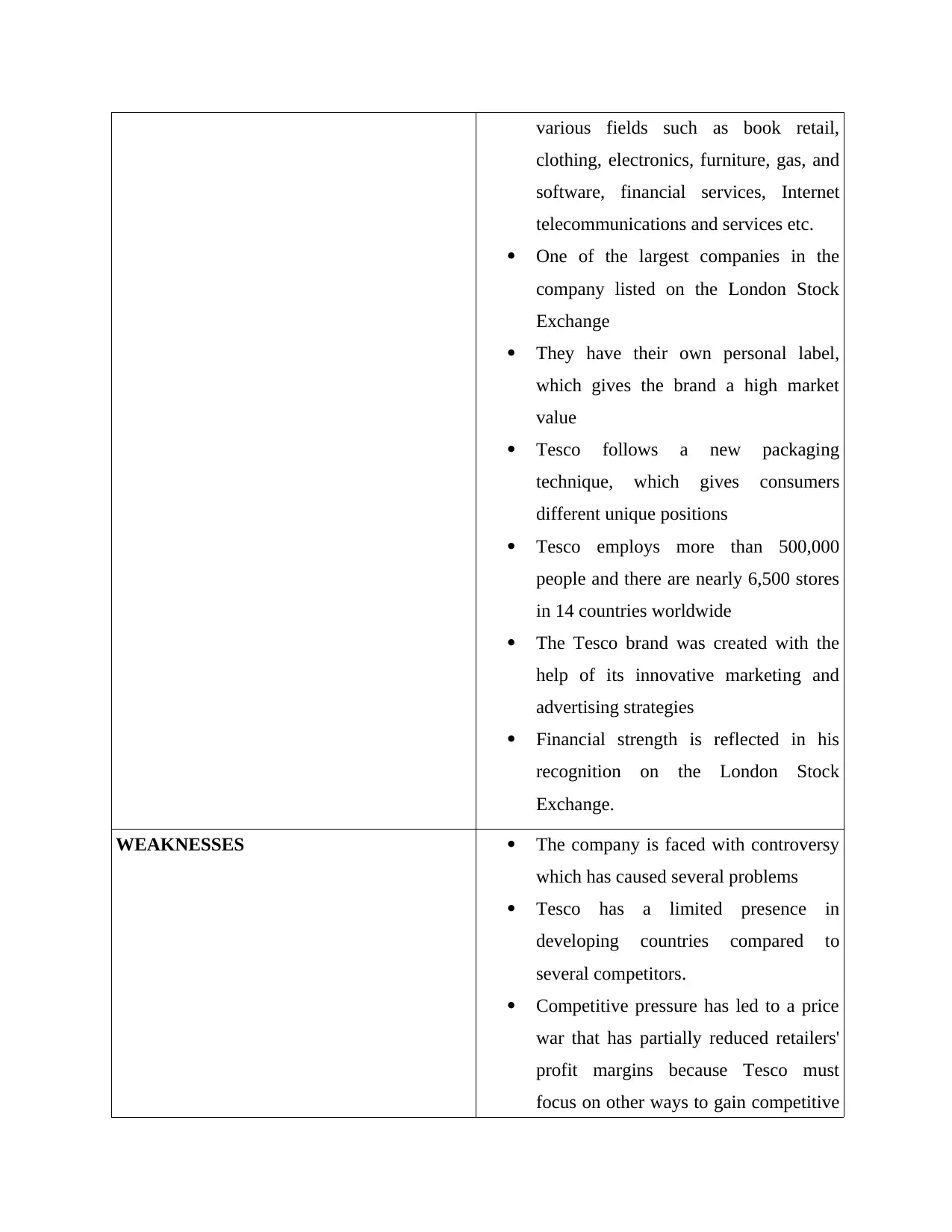
various fields such as book retail,
clothing, electronics, furniture, gas, and
software, financial services, Internet
telecommunications and services etc.
One of the largest companies in the
company listed on the London Stock
Exchange
They have their own personal label,
which gives the brand a high market
value
Tesco follows a new packaging
technique, which gives consumers
different unique positions
Tesco employs more than 500,000
people and there are nearly 6,500 stores
in 14 countries worldwide
The Tesco brand was created with the
help of its innovative marketing and
advertising strategies
Financial strength is reflected in his
recognition on the London Stock
Exchange.
WEAKNESSES The company is faced with controversy
which has caused several problems
Tesco has a limited presence in
developing countries compared to
several competitors.
Competitive pressure has led to a price
war that has partially reduced retailers'
profit margins because Tesco must
focus on other ways to gain competitive
clothing, electronics, furniture, gas, and
software, financial services, Internet
telecommunications and services etc.
One of the largest companies in the
company listed on the London Stock
Exchange
They have their own personal label,
which gives the brand a high market
value
Tesco follows a new packaging
technique, which gives consumers
different unique positions
Tesco employs more than 500,000
people and there are nearly 6,500 stores
in 14 countries worldwide
The Tesco brand was created with the
help of its innovative marketing and
advertising strategies
Financial strength is reflected in his
recognition on the London Stock
Exchange.
WEAKNESSES The company is faced with controversy
which has caused several problems
Tesco has a limited presence in
developing countries compared to
several competitors.
Competitive pressure has led to a price
war that has partially reduced retailers'
profit margins because Tesco must
focus on other ways to gain competitive
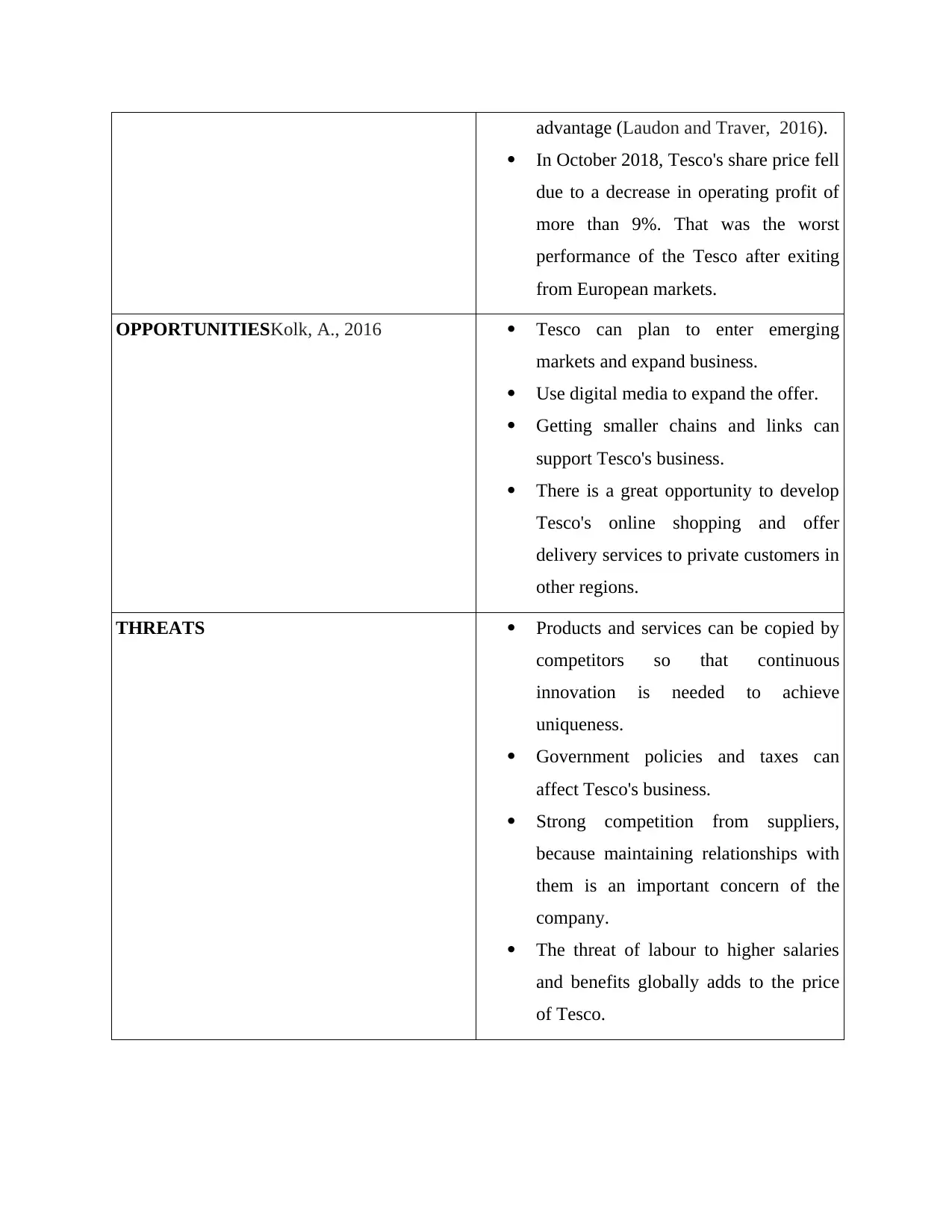
advantage (Laudon and Traver, 2016).
In October 2018, Tesco's share price fell
due to a decrease in operating profit of
more than 9%. That was the worst
performance of the Tesco after exiting
from European markets.
OPPORTUNITIESKolk, A., 2016 Tesco can plan to enter emerging
markets and expand business.
Use digital media to expand the offer.
Getting smaller chains and links can
support Tesco's business.
There is a great opportunity to develop
Tesco's online shopping and offer
delivery services to private customers in
other regions.
THREATS Products and services can be copied by
competitors so that continuous
innovation is needed to achieve
uniqueness.
Government policies and taxes can
affect Tesco's business.
Strong competition from suppliers,
because maintaining relationships with
them is an important concern of the
company.
The threat of labour to higher salaries
and benefits globally adds to the price
of Tesco.
In October 2018, Tesco's share price fell
due to a decrease in operating profit of
more than 9%. That was the worst
performance of the Tesco after exiting
from European markets.
OPPORTUNITIESKolk, A., 2016 Tesco can plan to enter emerging
markets and expand business.
Use digital media to expand the offer.
Getting smaller chains and links can
support Tesco's business.
There is a great opportunity to develop
Tesco's online shopping and offer
delivery services to private customers in
other regions.
THREATS Products and services can be copied by
competitors so that continuous
innovation is needed to achieve
uniqueness.
Government policies and taxes can
affect Tesco's business.
Strong competition from suppliers,
because maintaining relationships with
them is an important concern of the
company.
The threat of labour to higher salaries
and benefits globally adds to the price
of Tesco.
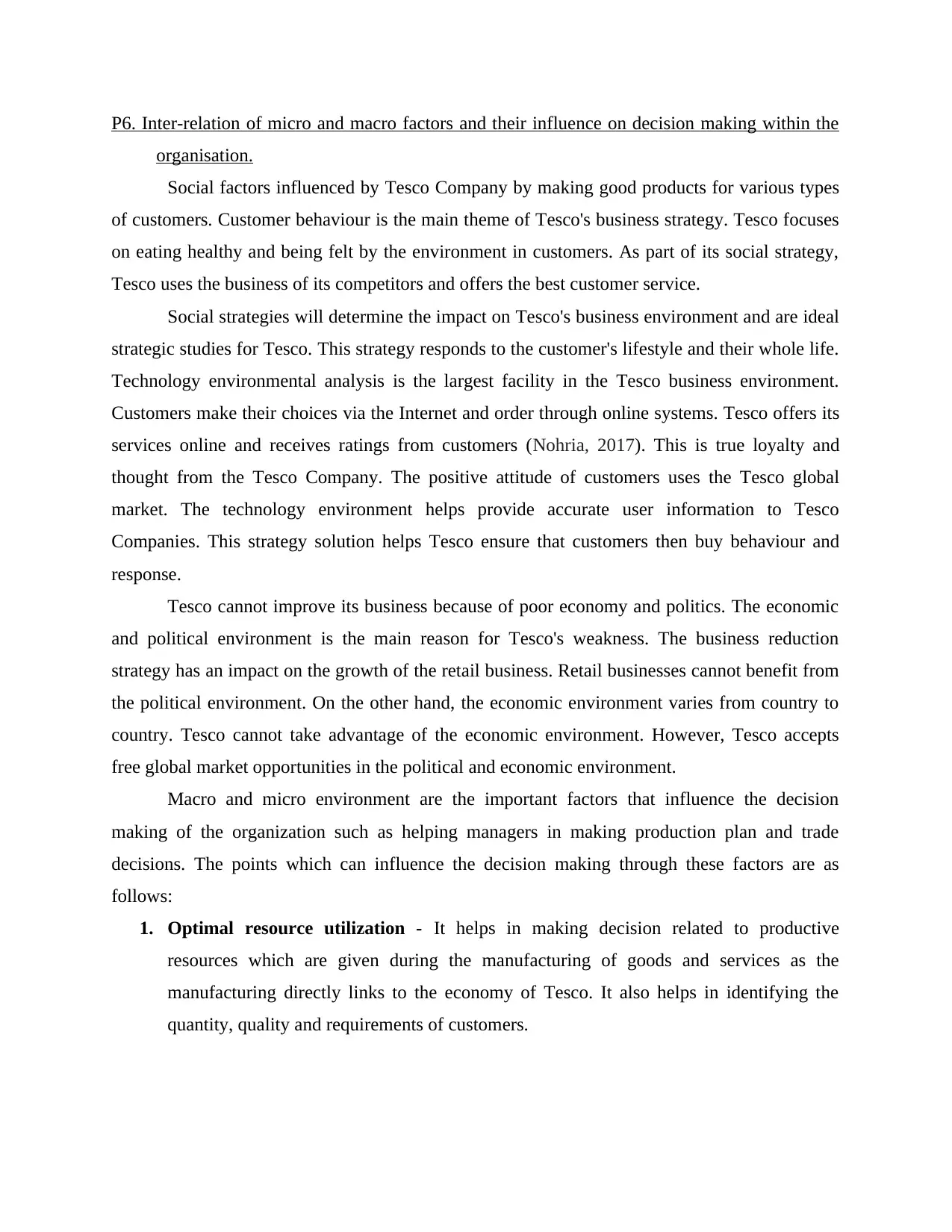
P6. Inter-relation of micro and macro factors and their influence on decision making within the
organisation.
Social factors influenced by Tesco Company by making good products for various types
of customers. Customer behaviour is the main theme of Tesco's business strategy. Tesco focuses
on eating healthy and being felt by the environment in customers. As part of its social strategy,
Tesco uses the business of its competitors and offers the best customer service.
Social strategies will determine the impact on Tesco's business environment and are ideal
strategic studies for Tesco. This strategy responds to the customer's lifestyle and their whole life.
Technology environmental analysis is the largest facility in the Tesco business environment.
Customers make their choices via the Internet and order through online systems. Tesco offers its
services online and receives ratings from customers (Nohria, 2017). This is true loyalty and
thought from the Tesco Company. The positive attitude of customers uses the Tesco global
market. The technology environment helps provide accurate user information to Tesco
Companies. This strategy solution helps Tesco ensure that customers then buy behaviour and
response.
Tesco cannot improve its business because of poor economy and politics. The economic
and political environment is the main reason for Tesco's weakness. The business reduction
strategy has an impact on the growth of the retail business. Retail businesses cannot benefit from
the political environment. On the other hand, the economic environment varies from country to
country. Tesco cannot take advantage of the economic environment. However, Tesco accepts
free global market opportunities in the political and economic environment.
Macro and micro environment are the important factors that influence the decision
making of the organization such as helping managers in making production plan and trade
decisions. The points which can influence the decision making through these factors are as
follows:
1. Optimal resource utilization - It helps in making decision related to productive
resources which are given during the manufacturing of goods and services as the
manufacturing directly links to the economy of Tesco. It also helps in identifying the
quantity, quality and requirements of customers.
organisation.
Social factors influenced by Tesco Company by making good products for various types
of customers. Customer behaviour is the main theme of Tesco's business strategy. Tesco focuses
on eating healthy and being felt by the environment in customers. As part of its social strategy,
Tesco uses the business of its competitors and offers the best customer service.
Social strategies will determine the impact on Tesco's business environment and are ideal
strategic studies for Tesco. This strategy responds to the customer's lifestyle and their whole life.
Technology environmental analysis is the largest facility in the Tesco business environment.
Customers make their choices via the Internet and order through online systems. Tesco offers its
services online and receives ratings from customers (Nohria, 2017). This is true loyalty and
thought from the Tesco Company. The positive attitude of customers uses the Tesco global
market. The technology environment helps provide accurate user information to Tesco
Companies. This strategy solution helps Tesco ensure that customers then buy behaviour and
response.
Tesco cannot improve its business because of poor economy and politics. The economic
and political environment is the main reason for Tesco's weakness. The business reduction
strategy has an impact on the growth of the retail business. Retail businesses cannot benefit from
the political environment. On the other hand, the economic environment varies from country to
country. Tesco cannot take advantage of the economic environment. However, Tesco accepts
free global market opportunities in the political and economic environment.
Macro and micro environment are the important factors that influence the decision
making of the organization such as helping managers in making production plan and trade
decisions. The points which can influence the decision making through these factors are as
follows:
1. Optimal resource utilization - It helps in making decision related to productive
resources which are given during the manufacturing of goods and services as the
manufacturing directly links to the economy of Tesco. It also helps in identifying the
quantity, quality and requirements of customers.
Paraphrase This Document
Need a fresh take? Get an instant paraphrase of this document with our AI Paraphraser
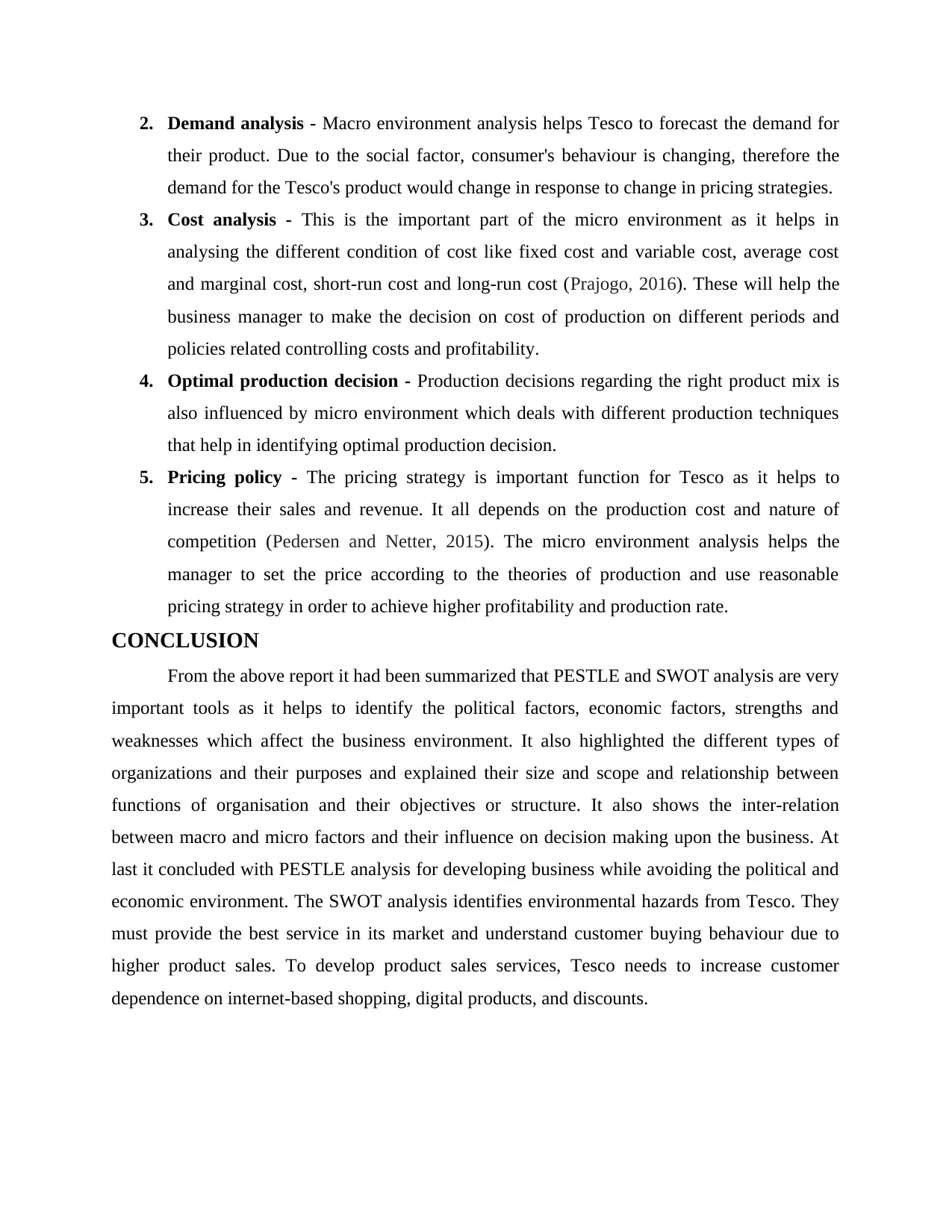
2. Demand analysis - Macro environment analysis helps Tesco to forecast the demand for
their product. Due to the social factor, consumer's behaviour is changing, therefore the
demand for the Tesco's product would change in response to change in pricing strategies.
3. Cost analysis - This is the important part of the micro environment as it helps in
analysing the different condition of cost like fixed cost and variable cost, average cost
and marginal cost, short-run cost and long-run cost (Prajogo, 2016). These will help the
business manager to make the decision on cost of production on different periods and
policies related controlling costs and profitability.
4. Optimal production decision - Production decisions regarding the right product mix is
also influenced by micro environment which deals with different production techniques
that help in identifying optimal production decision.
5. Pricing policy - The pricing strategy is important function for Tesco as it helps to
increase their sales and revenue. It all depends on the production cost and nature of
competition (Pedersen and Netter, 2015). The micro environment analysis helps the
manager to set the price according to the theories of production and use reasonable
pricing strategy in order to achieve higher profitability and production rate.
CONCLUSION
From the above report it had been summarized that PESTLE and SWOT analysis are very
important tools as it helps to identify the political factors, economic factors, strengths and
weaknesses which affect the business environment. It also highlighted the different types of
organizations and their purposes and explained their size and scope and relationship between
functions of organisation and their objectives or structure. It also shows the inter-relation
between macro and micro factors and their influence on decision making upon the business. At
last it concluded with PESTLE analysis for developing business while avoiding the political and
economic environment. The SWOT analysis identifies environmental hazards from Tesco. They
must provide the best service in its market and understand customer buying behaviour due to
higher product sales. To develop product sales services, Tesco needs to increase customer
dependence on internet-based shopping, digital products, and discounts.
their product. Due to the social factor, consumer's behaviour is changing, therefore the
demand for the Tesco's product would change in response to change in pricing strategies.
3. Cost analysis - This is the important part of the micro environment as it helps in
analysing the different condition of cost like fixed cost and variable cost, average cost
and marginal cost, short-run cost and long-run cost (Prajogo, 2016). These will help the
business manager to make the decision on cost of production on different periods and
policies related controlling costs and profitability.
4. Optimal production decision - Production decisions regarding the right product mix is
also influenced by micro environment which deals with different production techniques
that help in identifying optimal production decision.
5. Pricing policy - The pricing strategy is important function for Tesco as it helps to
increase their sales and revenue. It all depends on the production cost and nature of
competition (Pedersen and Netter, 2015). The micro environment analysis helps the
manager to set the price according to the theories of production and use reasonable
pricing strategy in order to achieve higher profitability and production rate.
CONCLUSION
From the above report it had been summarized that PESTLE and SWOT analysis are very
important tools as it helps to identify the political factors, economic factors, strengths and
weaknesses which affect the business environment. It also highlighted the different types of
organizations and their purposes and explained their size and scope and relationship between
functions of organisation and their objectives or structure. It also shows the inter-relation
between macro and micro factors and their influence on decision making upon the business. At
last it concluded with PESTLE analysis for developing business while avoiding the political and
economic environment. The SWOT analysis identifies environmental hazards from Tesco. They
must provide the best service in its market and understand customer buying behaviour due to
higher product sales. To develop product sales services, Tesco needs to increase customer
dependence on internet-based shopping, digital products, and discounts.

REFERENCES
Books and Journals
Chang, J. F., 2016. Business process management systems: strategy and implementation.
Auerbach Publications.
Charter, M., 2017. Greener marketing: A responsible approach to business. Routledge.
Deasy, S., and et.al., 2016.Controlling use of a business environment on a mobile device. U.S.
Patent 9,247,042.
Erasmus, B., Strydom, J. W. and Rudansky-Kloppers, S. eds., 2016. Introduction to business
management. Oxford University Press Southern Africa.
Hair Jr, J.F., and et.al., 2015. Essentials of business research methods. Routledge.
Hamilton, L. and Webster, P., 2018. The international business environment. Oxford University
Press.
Hillary, R. ed., 2017. Small and medium-sized enterprises and the environment: business
imperatives. Routledge.
Kljucnikov, A., and et.al., 2016. The entreprenurial perception of SME business environment
quality in the Czech Republic. Journal of Competitiveness. 8(1).
Kolk, A., 2016. The social responsibility of international business: From ethics and the
environment to CSR and sustainable development. Journal of World Business. 51(1).
pp.23-34.
Laudon, K. C. and Traver, C. G., 2016. E-commerce: business, technology, society.
Nohria, N., 2017. Fast forward: The best ideas on managing business change. Business
Review. 9. p.10.
Prajogo, D.I., 2016. The strategic fit between innovation strategies and business environment in
delivering business performance. International Journal of Production Economics.171.
pp.241-249.
Pedersen, E.R.G. and Netter, S., 2015. Collaborative consumption: business model opportunities
and barriers for fashion libraries. Journal of Fashion Marketing and Management, 19(3),
pp.258-273.
Prause, G., 2015. Sustainable business models and structures for Industry 4.0. Journal of Security
& Sustainability Issues. 5(2).
Svensson, G. and Wagner, B., 2015. Implementing and managing economic, social and
environmental efforts of business sustainability: propositions for measurement and
structural models. Management of Environmental Quality: An International Journal. 26(2).
pp.195-213.
Trkman, P., Budler, M. and Groznik, A., 2015. A business model approach to supply chain
management. Supply Chain Management: An International Journal, 20(6). pp.587-602.
Boddewyn, J.J., 2016. International business–government relations research 1945–2015:
Concepts, typologies, theories and methodologies. Journal of World Business. 51(1).
pp.10-22.
Doherty, B., Meehan, J. and Richards, A., 2015. The business case and barriers for responsible
management education in business schools. Journal of Management Development. 34(1).
pp.34-60.
Books and Journals
Chang, J. F., 2016. Business process management systems: strategy and implementation.
Auerbach Publications.
Charter, M., 2017. Greener marketing: A responsible approach to business. Routledge.
Deasy, S., and et.al., 2016.Controlling use of a business environment on a mobile device. U.S.
Patent 9,247,042.
Erasmus, B., Strydom, J. W. and Rudansky-Kloppers, S. eds., 2016. Introduction to business
management. Oxford University Press Southern Africa.
Hair Jr, J.F., and et.al., 2015. Essentials of business research methods. Routledge.
Hamilton, L. and Webster, P., 2018. The international business environment. Oxford University
Press.
Hillary, R. ed., 2017. Small and medium-sized enterprises and the environment: business
imperatives. Routledge.
Kljucnikov, A., and et.al., 2016. The entreprenurial perception of SME business environment
quality in the Czech Republic. Journal of Competitiveness. 8(1).
Kolk, A., 2016. The social responsibility of international business: From ethics and the
environment to CSR and sustainable development. Journal of World Business. 51(1).
pp.23-34.
Laudon, K. C. and Traver, C. G., 2016. E-commerce: business, technology, society.
Nohria, N., 2017. Fast forward: The best ideas on managing business change. Business
Review. 9. p.10.
Prajogo, D.I., 2016. The strategic fit between innovation strategies and business environment in
delivering business performance. International Journal of Production Economics.171.
pp.241-249.
Pedersen, E.R.G. and Netter, S., 2015. Collaborative consumption: business model opportunities
and barriers for fashion libraries. Journal of Fashion Marketing and Management, 19(3),
pp.258-273.
Prause, G., 2015. Sustainable business models and structures for Industry 4.0. Journal of Security
& Sustainability Issues. 5(2).
Svensson, G. and Wagner, B., 2015. Implementing and managing economic, social and
environmental efforts of business sustainability: propositions for measurement and
structural models. Management of Environmental Quality: An International Journal. 26(2).
pp.195-213.
Trkman, P., Budler, M. and Groznik, A., 2015. A business model approach to supply chain
management. Supply Chain Management: An International Journal, 20(6). pp.587-602.
Boddewyn, J.J., 2016. International business–government relations research 1945–2015:
Concepts, typologies, theories and methodologies. Journal of World Business. 51(1).
pp.10-22.
Doherty, B., Meehan, J. and Richards, A., 2015. The business case and barriers for responsible
management education in business schools. Journal of Management Development. 34(1).
pp.34-60.
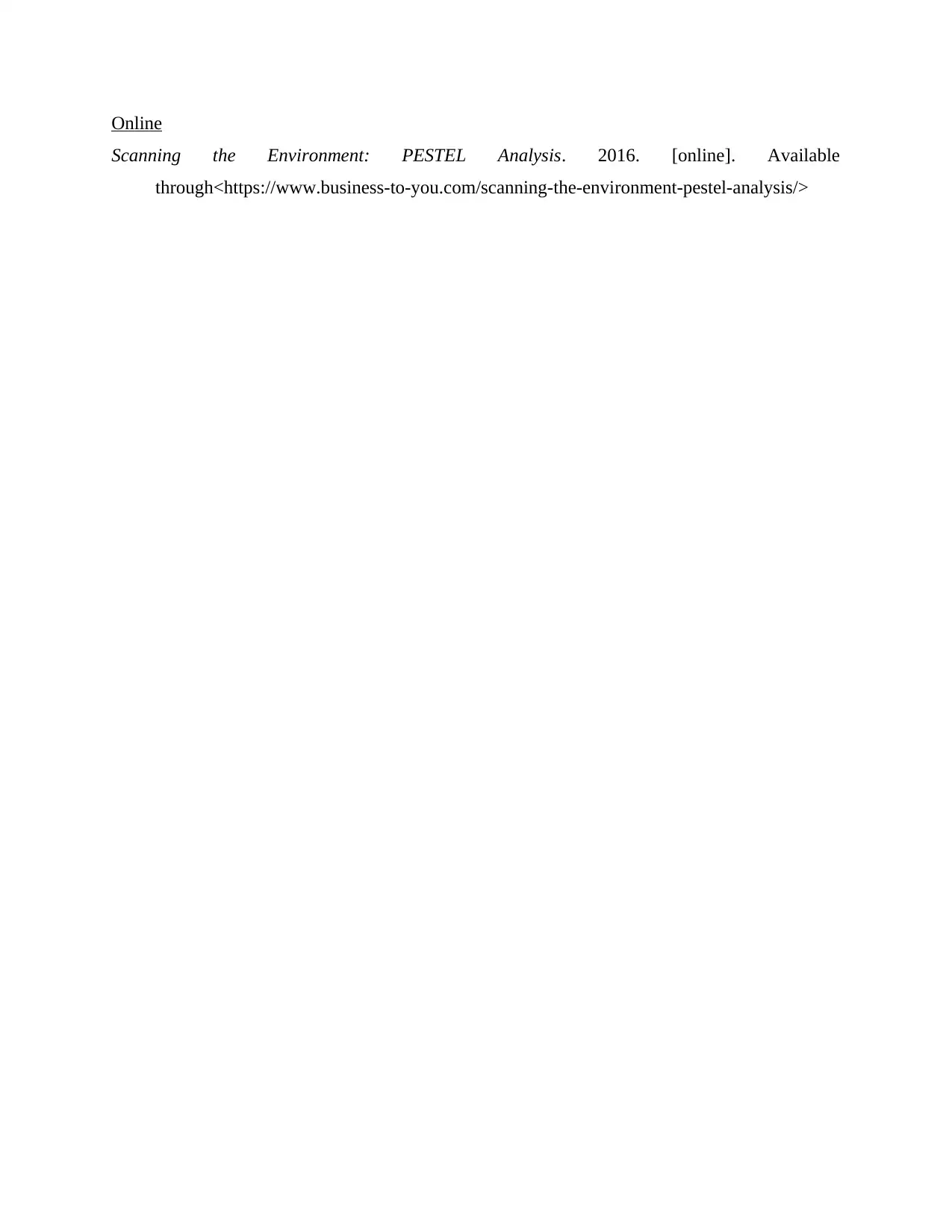
Online
Scanning the Environment: PESTEL Analysis. 2016. [online]. Available
through<https://www.business-to-you.com/scanning-the-environment-pestel-analysis/>
Scanning the Environment: PESTEL Analysis. 2016. [online]. Available
through<https://www.business-to-you.com/scanning-the-environment-pestel-analysis/>
1 out of 16
Related Documents
Your All-in-One AI-Powered Toolkit for Academic Success.
+13062052269
info@desklib.com
Available 24*7 on WhatsApp / Email
![[object Object]](/_next/static/media/star-bottom.7253800d.svg)
Unlock your academic potential
© 2024 | Zucol Services PVT LTD | All rights reserved.





